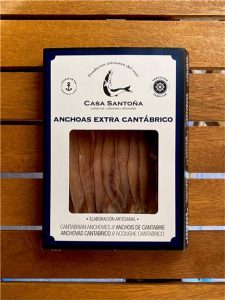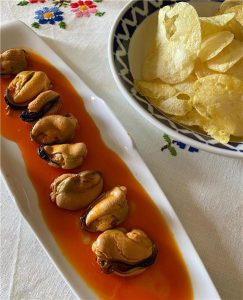
- Readers Rating
- No Rating Yet!
- Your Rating
When thinking of Spanish cuisine, it’s easy for the mind to conjure images of tapas, Iberian ham, paella, and red wine. However, one of Spain’s greatest culinary treasures, which has transcended borders, is the rich tradition of gourmet preserves. This method of preservation has not only allowed for the enjoyment of the abundance of marine and land products throughout the year, but it has also been the foundation of an artisanal industry that has elevated these foods to the status of gastronomic luxury.
The Importance of Preserves in Spain
Preserves in Spain are more than just a simple way to preserve food; they are an integral part of the country’s culture and culinary tradition. In Spanish pantries, it is not uncommon to find cans of mussels, anchovies, tuna, or asparagus. These preserves not only add flavor to everyday cooking, but they also take center stage in celebrations, informal dinners, and in the tradition of “tapeo,” which is as quintessentially Spanish as flamenco.
What distinguishes Spanish preserves from others and makes them a symbol of quality and prestige is the attention to detail in the selection of raw materials and the production process. Many of Spain’s canning factories, often small-scale and family-owned, employ traditional methods that have been refined over centuries. Often, products are selected and packaged by hand, ensuring a level of quality that few countries can match.
Additionally, the climate, especially in coastal regions like Galicia, has been key to the production of fish and seafood preserves. The Atlantic Ocean offers a rich marine bounty that, when canned, becomes a durable product without losing the quality and fresh taste of the sea.

Origin and Canning Tradition in Spain
The canning tradition in Spain has deep roots that date back to Roman times when rudimentary methods were already being used to preserve fish. During that era, garum, a sauce made from fermented fish, was a highly valued product throughout the Roman Empire, and the Spanish coasts, especially in the south, became important production centers.
However, the technique of canned preserves as we know it today began to take shape in the early 19th century, thanks to technological and scientific advances. The Frenchman Nicolas Appert was the first to discover that by heating sealed food in airtight containers, it could be preserved for long periods. This method was soon followed by the invention of metal cans in England.
In Spain, the first canned preserves factory was established in Galicia in 1840, in the town of O Grove. It is no coincidence that this region was the pioneer in the canning industry, as its coasts are rich in seafood and fish such as sardines, tuna, and mussels. Over time, other regions like Cantabria and the Basque Country joined this thriving industry, establishing Spain as a global benchmark in the production of preserves.
Gourmet Preserves from Spain
1. Cantabrian Anchovies
Buy Cantabrian anchovies on mentta

Cantabrian anchovies are perhaps one of the most emblematic products of the Spanish canning tradition. Caught in the cold, clear waters of the Cantabrian Sea, these anchovies are prized for their smooth texture and intense flavor. After being captured, the anchovies undergo a meticulous process that includes salting and curing, followed by hand filleting and packaging, a technique that has been passed down from generation to generation.
Anchovies are a versatile food and are often served as a tapa, accompanied by a drizzle of extra virgin olive oil or on a slice of bread with tomato. This delicacy is synonymous with gastronomic excellence, and many canneries have won international awards for the quality of their products.
2. Mussels in Marinade
Buy mussels in marinade on mentta

Another gem of the Spanish canning industry is mussels in marinade, particularly those from the Galician estuaries. Galicia is famous for the richness of its waters, where high-quality mussels are cultivated. The marinade, a mixture of vinegar, oil, paprika, and spices, gives the mussels an exquisite flavor, making them one of the most cherished preserves.
Mussels in marinade are a very popular tapa and are often consumed alone or accompanied by fries or bread. This product combines tradition and flavor, and its popularity has led to its export to multiple countries.
3. Sardines in Olive Oil
Buy sardines in extra virgin olive oil on mentta

Sardines in olive oil are a classic in any Spanish pantry. This fish, small in size but big in flavor, is primarily caught along the coasts of Galicia. The sardines are carefully selected, cleaned, and canned in olive oil, which acts not only as a preservative but also as a enhancer of their natural flavor.
As the months go by, canned sardines improve in flavor and texture, something that connoisseurs deeply appreciate. They can be enjoyed on their own, in sandwiches, or as part of fresh salads, and they are a rich source of omega-3 and protein.
4. Tuna in Olive Oil
Tuna in olive oil is one of the most common and cherished preserves in Spain. Unlike other canned tuna, which can be dry or tasteless, Spanish tuna canned in olive oil is distinguished by its tenderness and flavor. The tuna is primarily fished in the Atlantic and Mediterranean, and its quality is unmatched.
In the gourmet world, northern bonito tuna is the most valued. This type of white tuna, caught through artisanal fishing, has a tender texture and delicate flavor, making it ideal for salads, toasts, or simply enjoying on its own.
5. White Asparagus

Although many preserves in Spain focus on seafood, there are also true terrestrial gems, such as white asparagus. Grown primarily in Navarra, this asparagus has a soft texture and delicate flavor that makes it a delight. Canned at just the right cooking point, they retain their natural flavor and tenderness.
White asparagus is an excellent accompaniment in salads, cold dishes, or simply with a little mayonnaise. Its versatility and quality have made it one of the most appreciated vegetable preserves.
Benefits of Consuming Preserves
Preserves are not only practical and tasty, but they also offer a range of benefits that make them an attractive option for consumers.
1. Long Shelf Life
One of the main benefits of preserves is their long shelf life. When sealed in a vacuum and subjected to heat, canned foods can last for months or even years without losing quality. This makes them an ideal option for pantry storage, allowing you to enjoy high-quality products at any time.
2. Nutrient Preservation
Contrary to popular belief, preserves retain most of their nutrients intact. In many cases, the preservation process can even enhance the flavor and texture of the product, as is the case with sardines in oil, which become more tender over time. Additionally, many preserves are packed in olive oil, adding healthy fats to the diet.
3. Accessibility and Convenience
Preserves provide access to high-quality products year-round, regardless of the season. They are also extremely convenient: ready to eat straight from the can or with minimal preparation, making them easy to use in daily cooking or for special occasions.
4. Sustainability
The Spanish canning industry is characterized by its commitment to sustainability. Many producers use responsible fishing methods and ensure the complete utilization of resources. Moreover, the cans are recyclable, making them a more eco-friendly option compared to other packaging.
Spanish gourmet preserves are a true treasure that reflects centuries of tradition, respect for raw materials, and passion for gastronomy. From the Galician coasts to the Navarre gardens, preserves represent the best of Spanish cuisine, offering high-quality products that can be enjoyed anytime and anywhere. In addition to their practicality, these canned delights offer a burst of flavor, health, and sustainability, establishing Spain as a global benchmark in the art of preserving the best of its land and sea.
Do you enjoy Spanish cuisine and want to learn more about it? Visit our mentta blog and check out our articles.
